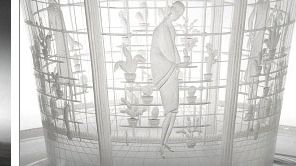
Press release -
New acquisition: Cactus Exhibition vase by Edward Hald
Nationalmuseum has acquired one of four known examples of Edward Hald’s Cactus Exhibition vase dating from 1926. This is a superb example of the high-quality glass, decorated in contemporary style, for which Orrefors was known in the early 20th century. One of the other examples is owned by Her Majesty Queen Elizabeth II.
Nationalmuseum has bolstered its collection of art glass with Cactus Exhibition, a vase designed in 1926 by Edward Hald (1883–1980). This example was produced by Orrefors in 1927 and engraved with great skill and precision by Wilhelm Eisert. Only four examples of the work are currently known to exist. Besides the vase now in Nationalmuseum’s collection, there is one in a museum in Dusseldorf (produced 1926), one in the Metropolitan Museum of Art in New York (produced 1926) and one in the possession of HM Queen Elizabeth II (produced 1931).
The Cactus Exhibition vase features a well-executed motif that clearly reflects the ideals of the day. The interior with its pillars, french windows and chandeliers frames the scene. The six panels contain three elegant ladies, dressed according to the fashion of the time with short skirts, shingled hair and small hats. Cactuses were likewise the height of fashion and were found in homes and parks alike. With his detailed, realistic motifs, Hald recalls Swedish artists such as Otte Sköld and Arvid Fougstedt.
Orrefors’ bold initiative to employ new, highly talented master glassblowers, engravers and artists in the 1910s gained the company worldwide renown as a manufacturer of high-quality glass decorated in contemporary style. Edward Hald was hired in 1917 to create unique art glass featuring forms and motifs with a contemporary feel. The lavishly engraved pieces were expensive, but there was a market for luxury goods in 1920s Sweden. As it turned out, too, the rest of the world soon started taking notice of this art glass from the forests of Småland.
Cactus Exhibition is a gift from the Friends of Nationalmuseum, with support from the Bengt Julin Fund. As a result, Nationalmuseum’s collection now boasts a showstopper piece of engraved glass from an era when Swedish glass enjoyed great success around the world. Nationalmuseum does not have a budget for acquiring works to add to its art and design collections, instead relying on gifts and financial support from private foundations and funds.
The new acquisition is currently on display in the exhibition Design 19002000 on the first floor.
Further information
Micael Ernstell, curator applied art and modern design, mel@nationalmuseum.se, +46 8 5195 4392
Hanna Tottmar, press officer, htr@nationalmuseum.se, +46 8 5195 4390, +46 767 23 46 32
Categories

